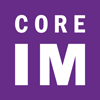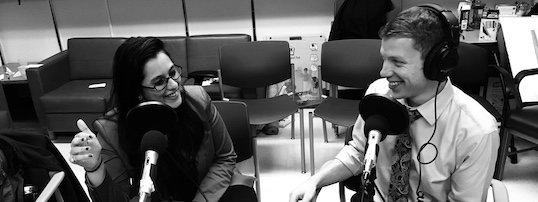Core IM
The Core IM team dives into Rhythm Control in Afib: 5 Pearls Segment with the recognition of paradigm shift and the latest guidelines in atrial fibrillation management. Specifically the guests for this episode will examine the indications for antiarrhythmic strategies, pathophysiology of atrial fibrillation progression, and indications for rate control.
Listeners will better understand what dictates current recommendations for rhythm control in atrial fibrillation, recognizing the risks and benefits of different antiarrhythmic strategies, and when to consider rate control. This episode with help learners gain a greater appreciation for the risks and benefits of antiarrhythmic strategies to make an informed decision with patients.
First, listen to the podcast. After listening, ACP members can take the CME/MOC quiz for free.
CME/MOC:
Up to 0.75
AMA PRA Category 1 Credits ™ and MOC Points
Expires April 23, 2027
active
Cost:
Free to Members
Format:
Podcasts and Audio Content
Product:
Core IM
Welcome to Core IM, a virtual medical community! Core IM strives to empower its colleagues of all levels and backgrounds with clinically applicable information as well as inspire curiosity and critical thinking. Core IM promotes its mission through podcasts and other multimodal dialogues. ACP has teamed up with Core IM to offer continuing medical education, available exclusively to ACP members by completing the CME/MOC quiz.

Pearl 1: What are the benefits of early rhythm control versus rate control alone?
-
Rhythm control demonstrates mortality and quality of life benefit over rate control.
- EAST-AFNET 4: Published in 2020, the trial showed that early rhythm-control therapy is associated with lower risk of adverse CV outcomes vs usual care
-
AFFIRM Subgroup analysis: Effective way of maintaining sinus rhythm may improve survival.
- Sinus rhythm, but not antiarrhythmic drug use, was associated with decreased mortality.
-
Reason why we may have not seen a difference in the primary endpoint:
- In the initial AFFIRM trial, warfarin was mandated in the rate control group but could be discontinued in the rhythm control group after 4 weeks in sinus rhythm.
-
Findings suggest an effective mechanism of maintaining SR may improve survival.
-
Why is sinus superior?
-
Structural dysfunction
- Atrial fibrillation can cause and/or exacerbate pre-existing heart failure (HF).
- Complex relationship between atrial fibrillation and heart failure is not completely understood.
- Increased risk of heart failure in AF - AF occurs in more than half of individuals with HF, and HF occurs in more than one third of individuals with AF
- Some proposed mechanisms of how afib precipitates heart failure:
- Tachycardia-mediated cardiomyopathy
- Atrial remodeling
- Loss of cardiac output from atrial kick
- Antecedent to valvular heart disease, including MR
- Some proposed mechanisms of how afib precipitates heart failure:
-
Symptoms
-
Can be subtle - people may not recognize symptoms until they convert.
-
Heart rhythm society guidelines recommend electrical cardioversion to tease out whether individuals are having symptoms or not.
-
Pearl 2: When is electrical cardioversion used and what information can it tell us?
-
Therapeutic use
- Can help acutely unstable or highly symptomatic patients.
- Use in patients too sick to wait for ablation or to be loaded on a drug.
-
Diagnostic use
- Electrical cardioversion is NOT intended to keep patients out of afib long-term.
- Provides information about relief of symptoms when in sinus.
- Can reveal if patients are “early return to AF” (ERAF), which suggests they more likely have “early” persistent AF or more advanced persistent AF.
- Provides data for future rhythm management strategies.
-
Patient considerations
-
Need to be anticoagulable!
- Anticoagulant for 4 weeks prior to electrical cardioversion and approximately 4 weeks after.
- Alternatively, can do TEE prior to cardioversion if unable to anticoagulant beforehand.
-
Optimize comorbidities to allow the greatest chance of success!
Pearl 3: Class III Antiarrhythmics and Side Effects
-
Amiodarone
- Oral amiodarone is a more gradual load, generally takes longer to convert than certain other class III and 1c antiarrhythmics.
- Good medication to start outpatient - less risk of conversion pauses that could make patients pass out.
- Better at maintaining sinus rhythm than sotalol or class 1c antiarrhythmics
- Additional study comparing amiodarone with sotalol
- Remember side effects: Pulmonary, thyroid, and hepatotoxicity (PFTs, TFTs, LFTs)
- Also photosensitivity, corneal and retinal deposits.
- Consider alternative agents in patients who will need to be on it long term.
- IV amio, on the other hand, has better bioavailability and does not take as long as oral amiodarone!
- Oral amiodarone is a more gradual load, generally takes longer to convert than certain other class III and 1c antiarrhythmics.
-
Dofetilide and sotalol
- Relative to oral amio, tend to decrease time to conversion.
- Watch out for those conversion pauses!
- QTc prolongation is a major side effect. Can require inpatient load over 3 days with serial EKGs.
- If patient misses > 2 doses, need to admit to be reloaded.
- Renally cleared
- May not be the best agent in patients with CKD or dynamic renal function.
- After the initial load, monitor outpatient EKGs, GFR, K, and Mg q3-6 months or more often if indicated.
- Numerous drug-drug interactions
- Sotalol is also contraindicated in patients with reduced left ventricular ejection fraction
- Based on results from the SWORD trial that demonstrated increased mortality when sotalol was used in HFrEF.
- Relative to oral amio, tend to decrease time to conversion.
Pearl 4: Class Ic Antiarrhythmics and Side Effects
-
Flecainide and propafenone (Class 1c antiarrhythmics)
- Compared to amiodarone, it accelerates time to conversion.
- Can be used for “pill in pocket” approach
- But patients must be able to feel when they go into afib!
- Otherwise if they take the pill after being in afib > 48 hours, risk having a stroke from an atrial thrombus.
- Can be used for “pill in pocket” approach
- Compared to amiodarone, it accelerates time to conversion.
-
Avoid in structural heart disease
- CAST trial demonstrated increased mortality (sudden death and lethal ventricular arrhythmias) in patients using flecainide or encainide with ischemic heart disease.
- Avoid in structural heart disease = systolic dysfunction and/or CAD.
- Gray area on whether need to avoid in nonobstructive CAD.
- Obtain stress EKG after fully loaded to eval for QRS widening and pro-arrhythmic effect.
- Can induce atrial flutter that conducts 1:1.
- Need to administer with a beta blocker or other AV-nodal blocking agent.
-
Flecainide specifically can also cause vertigo, double vision, blurriness and GI symptoms.
Pearl 5: When should catheter ablation be considered in patients with atrial fibrillation?
-
Guidelines recommend ablation may be considered a first-line option in select patients, particularly for:
- Young patients with symptomatic paroxysmal afib
- In symptomatic paroxysmal afib, EARLY-AF and STOP-AF trials have found that ablation was more effective in preventing atrial fibrillation recurrence versus drug therapy
- Earlier referral (i.e. within 6 months of diagnosis) in symptomatic paroxysmal afib has demonstrated less hospital utilization in the following 2 years
- In symptomatic paroxysmal afib, EARLY-AF and STOP-AF trials have found that ablation was more effective in preventing atrial fibrillation recurrence versus drug therapy
- Patients with HFrEF who are on GDMT.
- Improved cardiovascular mortality with ablation compared to drug therapy in patients with HFrEF, as demonstrated in CABANA trial subgroup analysis, AATAC, CASTLE-AF
- Young patients with symptomatic paroxysmal afib
-
In patients with normal structural function and persistent AF, requires risks/benefits discussion.
- Can present an opportunity to get off of medications.
- The role of ablation is being studied in other populations, including those with HFpEF
-
What to do with antiarrhythmic drugs after ablation
- Continue antiarrhythmics few months after ablation while cardiomyocytes heal.
-
Success rates vary.
- Some studies report >60% conversation rates for paroxysmal afib and <30% in persistent afib, however results largely vary on a case-by-case basis.
-
Ablation can also increase the efficacy of formerly unsuccessful antiarrhythmics
-
Risk of complications
- Complications to consider: stroke, atrial-esophageal fistula, tamponade, death, pulmonary vein stenosis, to name a few.
-
Who may not be best suited for ablation
- Advanced comorbidities that poses significant risk to general anesthesia.
- Patients who cannot be anticoagulated
- Asymptomatic paroxysmal atrial fibrillation
Contributors
Shreya Trivedi, MD, ACP Member – Author
Hanna Knauss, MD - Author
Abhi Gami, MD, ACP Member - Author
Rachita Navara, MD – Expert
Shu Yang, MD - Expert
Eric Prystowsky, MD – Expert
Reviewers
Robert Knotts, MD
Henry Huang, MD
Those named above, unless otherwise indicated, have no relevant financial relationships to disclose with ineligible companies whose primary business is producing, marketing, selling, re-selling, or distributing healthcare products used by or on patients. All relevant relationships have been mitigated.
Release Date: April 24, 2024
Expiration Date: April 23, 2027
CME Credit
This activity has been planned and implemented in accordance with the accreditation requirements and policies of the Accreditation Council for Continuing Medical Education (ACCME) through the joint providership of the American College of Physicians and Core IM. The American College of Physicians is accredited by the ACCME to provide continuing medical education for physicians.
The American College of Physicians designates this enduring material (podcast) for .75 AMA PRA Category 1 Credit™. Physicians should claim only the credit commensurate with the extent of their participation in the activity.
ABIM Maintenance of Certification (MOC) Points
Successful completion of this CME activity, which includes participation in the evaluation component, enables the participant to earn up to .75 medical knowledge MOC Point in the American Board of Internal Medicine’s (ABIM) Maintenance of Certification (MOC) program. Participants will earn MOC points equivalent to the amount of CME credits claimed for the activity. It is the CME activity provider’s responsibility to submit participant completion information to ACCME for the purpose of granting ABIM MOC credit.
How to Claim CME Credit and MOC Points
After listening to the podcast, complete a brief multiple-choice question quiz. To claim CME credit and MOC points you must achieve a minimum passing score of 66%. You may take the quiz multiple times to achieve a passing score.


